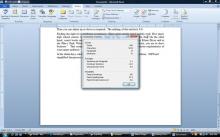Tips & Tricks: Readability Statistics
I don’t understand this right brain/left brain controversy. Perhaps that’s because I’m either an engineer who writes, or a writer who engineers. No matter how you slice it, creativity is a technical endeavor. Great prose doesn’t ‘just happen’—it is created during the editing process.
Today helpful editing tools are built right into Microsoft Word, a commonly used computer program available for both PCs and Macs. Most people rely on the spell checker and the ability to easily reformat text. Many are familiar with the “cut and paste” function. However, few writers use the SPELLING AND GRAMMAR routine.
Found under the REVIEW tab on the main menu ribbon, SPELLING AND GRAMMAR runs like spell checker. It points out potential grammatical errors and gives you the opportunity to make corrections as the program scans your text. In the end of the scan, “Readability Statistics” are calculated and published.
The statistics consist of three main categories―counts, averages and readability. Counts give you the number of words, characters, paragraphs and sentences in your file. Averages give sentences per paragraph, words per sentence and characters per word. Readability gives you the percentage of passive sentences, Flesch reading ease score and the Flesch-Kincaid grade level.
The first handy tool in the ‘Readability Statistics’ triad is the percentage of passive sentences. Editors have long implored writers to minimize their passive sentences. They slow down the read, create distance between the reader and the composition, and mark you as an amateur. Overuse of passive sentences is one of the items MWSA looks for while reviewing and judging your work. However, what is the proper percentage? It depends. I like to keep passive sentences in the 1% percent range for action passages in novels. I don’t mind going up to 2-4% for short stories and articles, but more than 6% makes me a little insane. However, you can use a higher percentage in dialogue. People in technical fields, victims, and military personnel tend to use passive voice when they speak more often than others.
It’s a good idea to evaluate your audience when choosing a percentage of passive sentences for a given piece. When I first wrote this article and ran the readability statistics, it came out 8% passive sentences—not acceptable for an audience of educated authors, editors, and publishers. I went back and transformed several passive sentences into active ones. When I finished, the number was 4%—this made the sentences shorter and simpler—and the whole piece easier to read.
Rudolph Flesch developed the Flesch reading ease score in the 1940s based on the physiology of human comprehension. It works like this: Your brain makes tentative decisions about what words mean as your eye scans the passage. When you get to a conclusive punctuation mark, you pause and assess what you have absorbed so far before arriving at a final meaning of all the words put together.
The longer the sentence, the more ideas your mind has to collect, store, and evaluate. That means you have to concentrate more. Longer words send more signals to your brain. ‘Love’ is short and sweet—and easy to understand. ‘Affectionate’ has more letters and more syllables to absorb and interpret. Thus, longer words in longer sentences make you work harder than shorter words in shorter sentences.
The Flesch reading ease score rates text on a 100-point scale. Measuring the average sentence length and the average word length, it puts the results into a formula. The higher the score, the easier it is to read your work. According to Rudolph Flesch, plain English has a score between 60 and 70. Below 40 is considered difficult to read. Comics rank above 90. ‘Reader’s Digest’ comes in around 65. The ‘Wall Street Journal’ rates a 43. The Internal Revenue Code is minus six. This article came out 57.3.
To establish a meaningful guideline for selecting a readability target, assess the reading level the editors of a given publication require by reviewing past issues or simply asking. If you are working on a book, the more general the audience you are targeting, the higher the readability score you should use—the more specific, the lower. Example, if you are writing a thriller aimed at a broad audience, set your goal at around 75%. If you are writing a technical article on sophisticated weaponry, you can set it down around 50% because of the specialized vocabulary in that field. To monitor the level of your manuscript, run the SPELLING AND GRAMMAR algorithm as you write. If your score is lower than the goal, break long sentences into shorter ones. Replace complex words with simple ones. If your score is higher than the goal, use a thesaurus to find alternate expressions. Add subordinate clauses to your sentences. After making your edits, re-check your Flesch score and adjust again as necessary.
Another way to control manuscript readability is by using the Flesch-Kinkaid algorithm. It rates text at the U.S. school grade levels. For example, a score of 4.0 means that a fourth grader can understand the passage.
The 1992 Adult Literacy Survey indicated almost half of American adults read at or below the eighth grade level. Therefore, a rating of 8.0 is a reasonable starting point for general audiences. Then you can adjust up or down as required. The ranking of this article is 8.6.
Finding the right level heightens acceptance. Many great stories aren’t widely read. How many high school seniors would select “Moby Dick” or “The Scarlet Letter” on their own? On the other hand, comic books remain popular, generation after generation. As author Eileen Dryer said at the Pike’s Peak Writer’s Conference, “If you intend to sell what you write, you are in show business.” That means setting your language goals to fit the comprehension requirements of your target audience.
In the olden days, calculating these scores on a document of any size was tedious. MSWord simplified the process and made it easy for authors to edit their work.



